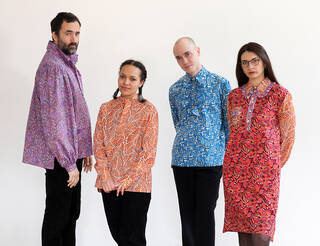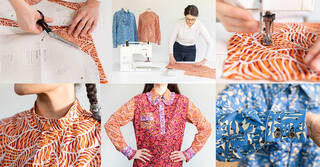Create your own stylish shirt inspired by flamboyant designs in our fashion collection, with our free, downloadable sewing pattern.
Combine historical flounces, frills and ruffles to create your own perfect shirt with this fully customisable, gender-neutral sewing pattern. Designed exclusively for the V&A by Alice & Co Patterns, the pattern features multiple collar and sleeve options – inspired by historic and contemporary shirts in our fashion collections.

Create a classic shirt with straight sleeves and two-button cuffs, or choose a high collar and billowy gathered sleeves for extra drama! There are opportunities to add a flourish of frills just about anywhere, and even a jabot for full flamboyance. With a slightly dropped shoulder, the relaxed fit accommodates a chest/bust size range of 85cm – 125cm, without being baggy. You can even extend the length to make a shirt-dress or night-shirt.

Instructions
This project is designed for an adventurous beginner/intermediate level sewer – you will learn how to sew a neat placket, turn a fine collar, and burrito a yoke.
Download the instructions (available in both A4 and US Letter) to get started:
Pattern
Before printing your pattern, take a look at our print layouts for A4, A0 and US Letter.
Print your pattern in full colour. The A4/US Letter formats can be printed at home using a standard printer, or you can print the A0 files at your local copy shop or with an online service. Be sure to print the test square first to check your printer settings are correct!

We'd love to see your creations! Share your photos with us on social media using the hashtags: #ArtofMenswear #BoysSewToo

From jabots to plackets – a brief history of the shirt
For centuries, shirts served as undergarments in the wardrobes of European, North and Latin American men: the layer between skin and outer clothing, and markers of cleanliness, wealth and social status. Made of expensive white linen, they were regularly laundered and starched, but remained invisible except for the fine ruffles at the wrists and neck – known as 'bosom ruffles'.
Before the 1800s, shirts didn't open all the way down the front, they had a simple T-shaped slit in the middle of the fabric to put your head through. The centre front placket, where the button-holes are placed, was a 19th-century innovation. Historically, ruffles on the cuffs and front of the shirt – known as a jabot – were detachable and worn only on formal occasions. They were often made from a finer grade linen or lace to show off the wealth and cleanliness of the wearer.
Men's shirts subtly changed in shape throughout the 1800s. A typical 1840s shirt had a high colour, pleated sleeves and a shirt front with starched pleats fastened with gold studs, revealed by a wide waistcoat neckline. When working women adopted a jacket-and-skirt version of the masculine suit in the late 1800s, the formal front-buttoning shirt with starched collar and cuffs also became part of women's wardrobes. By the 1950s, the shirt had graduated from underwear to visible outerwear, while 1960s 'flower-power' introduced a multitude of colours, patterns and fabrics.
Today contemporary designers from Prada, to Orange Culture to Harris Reed continue to explore the endless creative potential of the shirt.
Find more fun, easy-to-sew projects and craft activities on our Make & Do page.
Check out more designs from Alice & Co patterns.
Fabric generously provided by Storrs London.
In memory of our pattern tester Rob who inspired the #BoysSewToo movement to encourage boys of all ages to sew regardless of their skill and ability.







